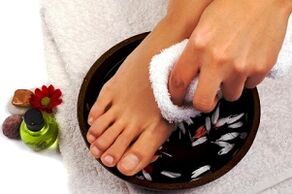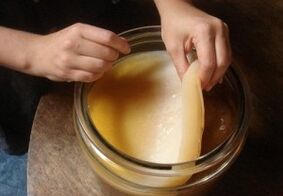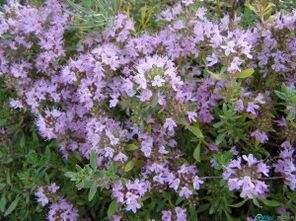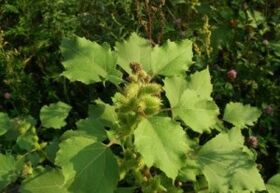
Treatment of nail fungus folk remedies are widely used in everyday life of people for many good reasons. First of all, this is the naturalness of such drugs and almost 100% absence of side effects (the only exception is, perhaps, the partial rejection of certain components of the body).
In addition, "folk" recipes can successfully complement the treatment of traditional medicines and often doctors themselves advise to combine them. Also, the price factor plays an important role in their popularity.
There are many folk recipes aimed at combating fungal diseases, including groin and ears. In this article, you can read the most efficient and most common of them.
Recipes that use herbs
This is the most popular category of folk remedies for nail fungus, because many modern pharmaceutical drugs contain components of the usual flora.

- Tea mushroom- one of the most common remedies against mycoses. Kombucha from nail fungus is mainly used in the form of lotions and compresses. The kombucha plate or part of it should be applied to the affected areas of the nail plates of the hands or feet, wrapped with waterproof material (cellophane is most often used) and clean socks should be put on. The procedure is performed in the evening, just before bedtime, the dressing is removed in the morning. After applying the coating, be sure to rinse the affected area with water and clean the nail plates, and then lubricate with iodine.
- Celandine. Another leading folk remedy for fungal infections. From nail fungus, celandine can be used both in pure form and in celandine oil. Soak the juice from the leaves or oil with cotton wool, apply to the nail damaged by the fungus and wrap. Keep such a compress for 4 to 5 hours. Lotions work until complete rehabilitation of nail plates.
- Kalanchoe. This common houseplant can also help fight fungal diseases. Separate the Kalanchoe leaf from the film that covers it, put it on the nail, wrap it in cellophane and put on a sock. Repeat every night until recovery, in the morning be sure to treat the nail plate with sterilized manicure accessories.
- Golden mustache. You can make a tincture of this plant yourself, but to save time you can buy it at the pharmacy. Recipe for tincture: 50 joints of "golden mustache" pour half a liter of vodka or pure alcohol, leave for 14 days. Then one part of the tincture should be diluted with three parts of water. Rub into the affected skin 2-3 times a day.
- Mint. Mix the crushed mint leaves with salt and distribute the obtained porridge in the interdigital folds for one hour. The compress is applied once or twice a day until recovery.
- Poultry or Indian onions. The juice of this plant helps with nail fungus and interdigital zone fungus. This juice must be gently rubbed into the infected areas of the skin 1 to 2 times a day until recovery.
- Spurge. Half a glass of dry herbal collection should be diluted with a liter of boiling water and infused for half an hour in a water bath. Use the infusion for 7-10 days.
- Cones and needles. Pour 250 grams of crushed needles or cones with alcohol (at least 70%) and leave in a dark place for two weeks. On average, such dressings should work for about two weeks.
- Thyme. Dilute 3-4 tablespoons of dried herbs in boiling water, leave to cool for an hour. Soak a soft cloth or bandage with the obtained solution and wrap the affected area. It is necessary to withstand the dressing for two hours twice a week.
- Rowan. Fresh crow leaves are good for removing harmful fungal spores in spring and summer. The crushed leaves are applied to the affected area of skin and fixed with a soft cloth (bandage). Lotions are made every day for 30 days.
- Air. The roots of this plant are sold in pharmacies. Grind the root, add 100 ml of boiling water, strain through a sieve. Take orally 2-3 times a day.
- Lilac. Another "spring" antifungal recipe. Add a glass of medicinal alcohol to fresh lilac flowers, leave for 15 days. Lubricate areas of fungus-damaged skin with the infusion.
- Pear. Crushed pear leaves have a healing effect similar to antibiotics. Dilute 1 teaspoon of crushed leaves with 250 grams of warm water and heat a little on the stove. After the solution has cooled, coatings can be applied to the affected areas.
- Garlic. Grind 1-2 cloves and add a little table salt, strain. Treat the affected skin with an infusion 2-3 times a day.
- Velcro. The fresh leaf of this plant should be wiped (in no case should it be washed under running water), the veins on the inside of the leaf should be softened a bit (so that vegetable juice appears) and the affected area smeared with it, then repaired with a bandage and left for several hours. The procedure is performed within three weeks.
- cocklebur. Squeeze the juice from the leaves, soak a cotton swab or other absorbent material with it and apply to the infected skin until complete recovery.
- Herbal mixture:marigold, oak bark, blackberry, verbena, horsetail grass. Pour approximately the same amount of ingredients with 200 grams of water, put on the stove and cook for 20 minutes. Leave the solution for 2-3 hours, it can be taken orally or used for dressings. Inside - one tablespoon 3-4 times a day. Apply compresses before bed.


Folk remedies for nail fungus using medications
Despite the fact that the main ingredients of such folk recipes are sold in ordinary pharmacy, they still have a number of characteristics that distinguish them from highly specialized antifungal ointments. First, the price varies significantly (as a rule, it is much lower), and secondly, "folk" medicines are just one of the components of the recipe, and the method of their application has been developed for decades. Below is a list of the most popular and economical ways to treat fungal infections.
- Propolis. Treatment of nail fungus with propolis, along with "herbal" recipes, is a very effective and popular recipe of traditional medicine. Moisten a cotton swab with propolis tincture (20%) and apply to infected areas of skin or nail plate. Apply until a healthy nail grows.
- Eucalyptus oil. You can get a good antifungal ointment from eucalyptus tree oil. It is necessary to mix 30-40 grams of oil with 15 grams of honey and add half a spoon of apple cider vinegar. Leave the mixture for three days in a cool, dark place. Lubricate the affected area of skin once a day until the symptoms of the disease disappear.
- Hydrogen peroxide. Before applying the solution, it is necessary to evaporate the nail plates damaged by the fungus, and only then carefully apply the solution with a cotton swab. Wipe the skin twice a day until the signs of illness disappear.
- Salicylic ointment.Treat damaged areas of skin and nail plates with 35% solution of this ointment before going to bed, then wrap with cellophane and put on socks. Repeat the procedure until complete recovery.
- rosemary oil. Rosemary is also good for nail fungus on the feet and hands. The oil is suitable for hand, foot and torso treatments. Apply at bedtime until the signs of mycosis disappear.
- Iodine. Treating nail fungus with iodine is one of the simplest but most effective ways to fight fungal diseases. 5% iodine solution is gently applied to the infected areas of the skin at least twice a day. The duration of the procedure is 20 days. However, severe stinging may occur when using the drug. In this case, the number of rubs should be reduced to 1 time per day.
- A solution of glycerin, iodine and vinegar. Mix in the following proportions: one tablespoon of glycerin, iodine, vinegar, 2 tablespoons of boiled water. Apply the resulting solution to the affected skin overnight.
- Birch tar. It is sold in any pharmacy, and it is recommended to wash your feet well with laundry soap before use. Method of application: soak a cotton swab with tar and apply to the affected areas, then wrap the foot with a bandage and put on a clean sock. You can also use a special tar soap for nail fungus.
Folk recipes against fungi "from the pantry"
You can find this category of folk remedies against fungal infections right on the kitchen shelves of your home. Treatment of nail fungus with such folk remedies is in no way inferior in popularity to traditional remedies. The most popular products and recipes from them:
- Coffee. A very popular remedy for mycosis, and therefore one of the most effective. It is necessary to brew strong coffee beans and leave it to cool down a bit, and then briefly lower your hands or feet into the beverage. From the fungus on the nails, coffee helps almost immediately: the itching disappears, the skin becomes softer and healthier looking.
- Vinegar. The treatment of nail fungus with vinegar is carried out as follows: the feet should be dipped in apple or wine vinegar for a few minutes, after washing them well. The most common treatment is vinegar for fungus on the feet.
- Lemon. The feet should be well steamed, then dip a cotton swab in lemon juice and make a compress that does not last longer than an hour.
- Sol. Sea salt from nail fungus is used in the form of daily foot baths (hands can also be steamed). Recipe: Dissolve 100 grams of sea salt and 4 tablespoons of apple cider vinegar in 5 liters of boiled water, dip your feet in the resulting solution for half an hour.
- Vodka. In a quarter cup of vodka, add a teaspoon of lemon juice and half a teaspoon of potassium permanganate, stir, leave for 3-5 days. Infected areas of skin and nail plates should be treated with the infusion twice a day.
- Egg shell fat, vinegar and butter. Pour vinegar into an empty egg and place in a dark place, after the shell has melted, remove the film, and add butter to the resulting mixture. Treat skin and nails twice a day until recovery.















